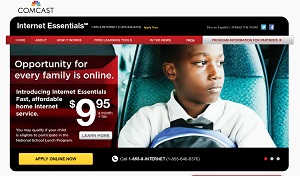Comcast Extends ‘Internet Essentials’ Program, To Offer $1M In Grants

Comcast announced Tuesday that it will enhance and extend Internet Essentials, the MSO's Internet adoption program for low-income households, beyond an initial three-year commitment that was scheduled to end this June.
Comcast will now run the Internet Essentials program "indefinitely," Comcast EVP David Cohen said Tuesday on a call with reporters. He labeled Internet Essentials Comcast’s “signature community investment priority.”
Internet Essentials, spawned from a voluntary commitment linked to Comcast's acquisition of NBCUniversal, targets low-income households with school-age children who are eligible to receive free lunches under the federally assisted National School Lunch Program. Qualified households receive discounted Internet service from Comcast at $9.95 per month (5 Mbps downstream by 1 Mbps upstream), the option to purchase an Internet-ready PC for under $150, and access to a free Internet training.
Comast's bigger commitment to Internet Essentials coincidentally comes as Comcast seeks approval of its proposed $45 billion acquisition of Time Warner Cable. Cohen said the merger, once closed, will give Comcast an opportunity to offer Internet Essentials to 19 of the nation’s 20 largest markets, including New York City, Kansas City and Los Angeles.
Also on Tuesday, Comcast said 1.2 million low-income Americans, or 300,000 families, have connected to the program, noting that it has invested more than $165 million in cash and in-kind support through its digital divide programs since 2011. Among other milestones, Comcast said it has provided free digital literacy training and education to more than 1.6 million people, broadcast more than 3.6 million public service announcements (valued at nearly $48 million), and sold more than 23,000 subsidized computers.
Last August, when Internet Essentials entered its third year, Comcast said more than 220,000 families and 900,000 Americans were on board, estimating that new, expanded eligibility criteria to include parochial, private and homeschooled students meant that nearly 2.6 million U.S. families were eligible for the program. Comcast said it now offers Internet Essentials in more than 30,000 schools in 4,000 school districts in 39 states, and Washington, D.C.
Cohen estimated that the program is approaching 9% to 10% penetration among families that are eligible for it.
Multichannel Newsletter
The smarter way to stay on top of the multichannel video marketplace. Sign up below.
As part of its broader commitment, Comcast also said it will give away $1 million in grants to 15 “Gold Medal” communities (see below) that have done the most to help close the so-called digital divide. Those funds will be used to create “Internet Essentials learning Zones” for non-profits, libraries and computer centers.
Comcast will also recognize five other communities as being the “most improved.” But instead of getting grants, those communities, along with the 15 that are awarded grants, will be part of a program that will offer eligible, qualified families in those areas that are new to the program to get Internet Essentials for free for six months if they sign up by March 18.
The 15 Gold Medal recognized communities that will create Internet Essentials Learning Zones include: Adams County, Colo.; Atlanta, Ga.; Aurora, Colo.; Chicago, Ill.; Cicero-Berwyn, Ill.; Collier, Fla.; Denver, Colo.; Elk Grove, Calif.; Fresno, Calif.; Miami, Fla.; Palm Beach, Fla.; Pasadena, Texas; Seattle, Wash.; St. Paul, Minn.; and Tacoma, Wash. The five “most improved” communities are: Baltimore County, Md.; Lee, Fla.; Philadelphia, Pa.; San Francisco; and Stockton, Calif.
Philadelphia Mayor Michael Nutter phoned in to express his support in the program, noting that just shy of 30% of people in the city don’t have access to the Internet. “Internet is the access issue in the 21st century.” He also said he is a “strong supporter” of the TWC-Comcast merger. Comcast is headquartered in Philadelphia and the MSO recently announced plans to build a second tower in the city.
“In just two and a half years, this groundbreaking initiative has connected more than 1.2 million low-income Americans, or 300,000 families, to broadband Internet at home,” said Comcast's Cohen, in a statement “We are also proud to join President Obama’s call to action for helping to realize his ConnectED educational goals as we announce today an extension and enhancement of our multi-year commitment to close the digital divide. Here at Comcast, addressing the digital divide head-on has long been a priority for our company. We believe the Internet has the power to transform lives, strengthen communities, and inspire a new generation of leaders.”
Dr. John B. Horrigan, head of research for the FCC’s National Broadband Plan and a former research director with Pew Research Center’s Internet and American Life Project, released the results of an “Essentials of Connectivity” study that found that 83% of schools expect students to have home access to the Internet. The study was based on a survey of 1,959 Internet Essentials customers conducted in the later part of 2013.
Horrigan said the Comcast-run program offers a “very strong, solid framework for closing broadband adoption gaps.”
Cohen was asked if Comcast would look to expand or tweak the program help it reach other low-income Americans. Cohen said it was “an active subject of discussion” at Comcast, noting that the MSO had conducted a pilot with AARP.
Comcast has also been testing a pre-paid Internet product that’s available to consumers who do not already subscribe to services from the MSO or do not otherwise qualify for a post-paid service.
